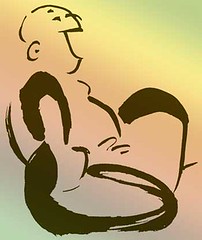Helpful Suggestions about the Practice of Buddhist Meditation
(the March 4 Compassionate Living Tip from Interfaith Paths to Peace)
http://buddhismnow.wordpress.com/2010/01/25/notes-on-buddhist-meditation/
Try to sit as still as possible without coughing or fidgeting. This is to see what is happening in the mind and body. The Buddha likened this ‘sitting still’ to trying to train a wild monkey.
Sitting without moving is not a ‘macho’ thing nor is it ‘self-torture’. The idea is to just watch what goes on. There are also insights into the nature of the mind and body which come from being still, inwardly and outwardly. If we have to move, we should do so with awareness to the intention and motive as well as the movements.
Some people like to watch the breath at the nostrils — cool on the in breath, warm on the out breath. Others watch the movement of the abdomen as it gently rises and falls with the breath. To begin with this helps to focus the concentration. Then when the mind has settled they just sit with an ‘awake’ state of mind. This is likened to being like a still pool in the forest where all kinds of animals and insects can come and drink.

Buddhist Meditation is not normally thought of as a process of attainment or failure. Learning about ourselves is its practice and awareness is its function. Those with experience of sitting may be able to sit with a perfect posture and for longer, but the awareness of the beginner and the awareness of the experienced meditator is the same. In fact all Buddhists are encouraged to keep the fresh enthusiasm of the beginner.
Nor is meditation an intellectual pursuit. As Dogen the famous Zen teacher said, ‘we should not assume that what is attained will inevitably become self-conscious and be recognised by the intellect’ (Genjo-Koan from the Shobogenzo).
There are no real obstructions to meditation. Some meditators complain about aches and pains in their legs and back. Others complain that they think too much, but thoughts and bodily discomfort are all part and parcel of life, so are therefore part and parcel of meditation. Buddhist meditation is something we endeavour to practise at all times — practice and experience are inseparable.
(the March 4 Compassionate Living Tip from Interfaith Paths to Peace)
http://buddhismnow.wordpress.com/2010/01/25/notes-on-buddhist-meditation/
Try to sit as still as possible without coughing or fidgeting. This is to see what is happening in the mind and body. The Buddha likened this ‘sitting still’ to trying to train a wild monkey.
Sitting without moving is not a ‘macho’ thing nor is it ‘self-torture’. The idea is to just watch what goes on. There are also insights into the nature of the mind and body which come from being still, inwardly and outwardly. If we have to move, we should do so with awareness to the intention and motive as well as the movements.
Some people like to watch the breath at the nostrils — cool on the in breath, warm on the out breath. Others watch the movement of the abdomen as it gently rises and falls with the breath. To begin with this helps to focus the concentration. Then when the mind has settled they just sit with an ‘awake’ state of mind. This is likened to being like a still pool in the forest where all kinds of animals and insects can come and drink.

Buddhist Meditation is not normally thought of as a process of attainment or failure. Learning about ourselves is its practice and awareness is its function. Those with experience of sitting may be able to sit with a perfect posture and for longer, but the awareness of the beginner and the awareness of the experienced meditator is the same. In fact all Buddhists are encouraged to keep the fresh enthusiasm of the beginner.
Nor is meditation an intellectual pursuit. As Dogen the famous Zen teacher said, ‘we should not assume that what is attained will inevitably become self-conscious and be recognised by the intellect’ (Genjo-Koan from the Shobogenzo).
There are no real obstructions to meditation. Some meditators complain about aches and pains in their legs and back. Others complain that they think too much, but thoughts and bodily discomfort are all part and parcel of life, so are therefore part and parcel of meditation. Buddhist meditation is something we endeavour to practise at all times — practice and experience are inseparable.
No comments:
Post a Comment